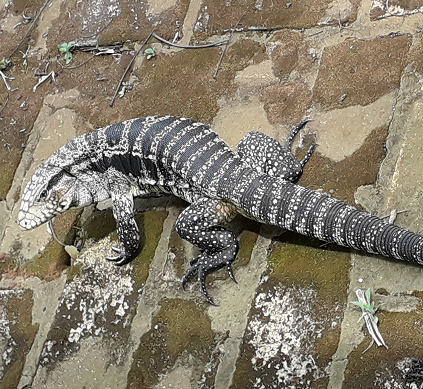Tegus are large terrestrial lizards. They are very distantly related to the monitor lizards. However they belong in a family of their own. The Teiids.
There are several species of Tegu and they are found throughout Southern America. They vary in size, coloration, habitat and lifestyle. Each filling its own ecological niche.
The species of Tegu found across Paraguay is the Argentine Black and White Tegu. This has the scientific name Salvator Merianae.
The Black and White Tegu is the largest of the Tegu species. It reaches a length of one and a half metres and is a formidable reptile.
These Tegus are common all across Paraguay. They are able to adapt to and thrive in most habitats. They are equally at home in swamps, rain forests, savanna or cities. Only high mountains and dry deserts are unsuited to them.
The tegu is a stockily built lizard. It has four solid limbs armed with sharp claws and a thick fleshy tail. Confident in their size and with their power they walk with a firm determined gate and look nonchalantly upon all around.
Despite the size of a Tegu and its ability to put on a burst of speed when required they do not hunt large prey. Instead the animals that are taken are invertebrates and other small creatures.
Meat is not in the wild their sole source of sustenance. A Tegu is omnivorous as happy eating fruits as frogs. They do though have a taste for eggs and will seek them out wherever they can be found.
A such they are not welcome by small country farmers with a few chickens to produce eggs for the family.
In the wild Tegus have a life span fitting of their great size. They commonly live for between 15 and 20 years. During that time they build a home territory and are aggressively territorial in protecting it.
As with all lizards they need heat to function efficiently. Theirs is a large body to warm up and get active. So they are at large as long as the weather remains warm enough.
In winter the days are often too cold for their liking. To get through this colder part of the year a Tegu will partially hibernate down in its burrow. From there stirring just on those days when the temperature rises sufficiently.
As such large and abundant creatures Tegus have been harvested for hundreds of years in both Paraguay and Argentina. Initially for their meat and skin and then in more recent times for the overseas pet trade.
For the inhabitants of the countryside the flesh of the Tegu is considered a delicacy. A welcome addition to an otherwise unvaried diet and the tough skin a useful material.
This harvest continues to this day with an estimated 300,000 Tegus taken ever year. As large though as this number may seen Paraguay has received recognition from conservation groups for its sustainable management of the Tegu population.
The populations retain abundant numbers and there are no signs of depopulation occurring anywhere within the home ranges of the Tegus.
These days with more and more demand from overseas for exotic pets the proportion of Tegus taken alive as opposed to dead is continuing to increase.
Once taken from the wild and treated as pets Tegus take on a much calmer personality. Having no longer to fight for a territory the aggression fades away and is replaced to a docility ideally suited to a loyal pet.
A Tegu will become loyal and trusting towards their owner and is intelligent enough to even be house trained.
Additionally a domesticated is quite capable of living far beyond the 15 to 20 years expected of a wild one.
In my time in Paraguay I have had a few meetings with Tegus. Either calmly crossing a street or casually strolling past as I sat reading a book.
For a while several years ago there was a baby one living on the terrace out of sight of potential predators. After a few months he disappeared but I believe the full grown Tegu I see from time to time in the garden or in my wood is one and the same.


I do not fancy having pet Tegu – do they make any noise?
No very quiet. You would not hear it coming
Wow that was strange. I just wrote an very long comment but after I clicked submit my comment didn’t show
up. Grrrr… well I’m not writing all that over again. Regardless, just
wanted to say wonderful blog!
Hi to every body, it’s my first visit of this web site;
this blog consists of amazing and actually excellent
information for visitors.
Greetings from Carolina! I’m bored to death at work so I decided to browse your
blog on my iphone during lunch break. I really like the
info you provide here and can’t wait to take a look when I
get home. I’m amazed at how fast your blog loaded on my mobile
.. I’m not even using WIFI, just 3G .. Anyhow, fantastic site!
my web page; slot via pulsa